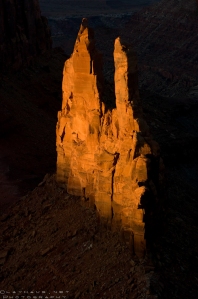Day two of our workshop with Tom Till and Jon Fuller found us heading out early on the Potash Road. The Gooseneck was our sunrise destination, but that didn’t mean much to me. The last time I had been on that bouncy dirt road was some 27 years before in a beat-up late-70’s model Datsun. But that’s another story for another time. As it was, our little convoy arrived yet again in the nick of time to capture the effects of the rising sun. (I have since affectionately taken to calling just in time arrivals, “Tom Till Time.”) Our location was off of a little spur road directly below the massive Dead Horse Point lookout, some 1600 feet above us. I’m sure that anyone up there had a nice view, but we were IN it. The reddish-orange glow of the huge gooseneck butte loomed before us, the Colorado River turning to flame as sunrise began to claim the day. We only had fifteen minutes or so of shooting before the canyon walls turned hotter and the magical glow left the river.
Tom and Jon quickly gathered us up (me lingering as usual) for a short drive back along the Potash Road to a location which Jon dubbed Crinoid Corners, because of the large amount of fossilized Jurassic-era sea plants found here and there. Interesting, but not being paleontologists we were more motivated to see and shoot the pillow rock formations below us, the blazing red cliff walls receding westward towards the Shafer Trail, the silhouetted La Sal Mountains to the East, and southward a series of ramparts – the Canyon Rim area – partially framing Lockhart Basin. Tom and Jon brought us here to shoot every direction including into the sun. Doing the latter – especially with a long telephoto lens – will give you that nice layered look and I thought the B&W conversions worked particularly well. (Shooting at an acute angle to the sun will often yield those nasty lens flares. Using a hat is helpful to block them but I also usualy carry my trusty Flare Buster.)
Back in Moab we went our separate ways for lunch. Not wanting to waste time in a restaurant, I drove south with my sandwich to photograph some early Fall colors in dry washes and Wilson Arch, alongside Hwy 191. Post lunch, Tom had put aside a couple of hours to critique images we had selected from our respective portfolios. This time was incredibly valuable from a number of perspectives. There is of course the ego factor if he happens to say something nice about one of your pieces, but let’s put that aside and discuss constructive points. Looking through a pro’s eyes while he dissects images opens your eyes to what can be seen. As untrained critics (I submit that we are ALL critics, trained or not, knowledgeable or nay) we may well miss composition details for the whole, or not understand what exactly it is about an image that does not work. Whilst reviewing your work, what we want to hear is that you are on track, or if not, what it would take to put you on back on track. Look for the common threads, the “too much empty space” or “too centered” “need to get closer” or in my case the “interesting compositions…I have never seen this shot like that...that gives me ideas!” For me, this was validation that I am on the right path and that I am developing a unique vision.
Our sunset location was a Zeus mallet of a hoodoo called Elvis’ Hammer. Also called Olympic Torch, this rock structure is located east of Moab with no obvious trail leading to it. We took the “scenic route” and hiked past some other smaller hoodoos. There are many sandstone shelves around the Hammer so we were able to creatively set ourselves up in plenty of time for dusk. I positioned myself on a lower remnant of what must have once been Elvis’ Fin and proceeded to document the waning light. I frankly didn’t think the sunset was going to be all that dramatic, but Tom kept saying that it was going to be “nice.” As the sun dipped below the horizon, it was more than nice…high, wispy clouds slowly ignited into a Duraflame kaleidoscope that stretched across the sky. As the light continued to descend – and we packed up our gear – a soft magenta glow around the Hammer became our swan song. I wisely choose not to put away my camera and tripod and shot well past the others, even while exiting in the growing dark. My motto became: never pack it away, or something to that effect.
Sound business advice, exposure to quasi-unknown locations, technical tips with the voice of experience, encouraging and helpful critiquing stirred in with two days of shooting … what is not to like about taking a workshop from a pro? Thanks Tom and Jon and see you next time!
















